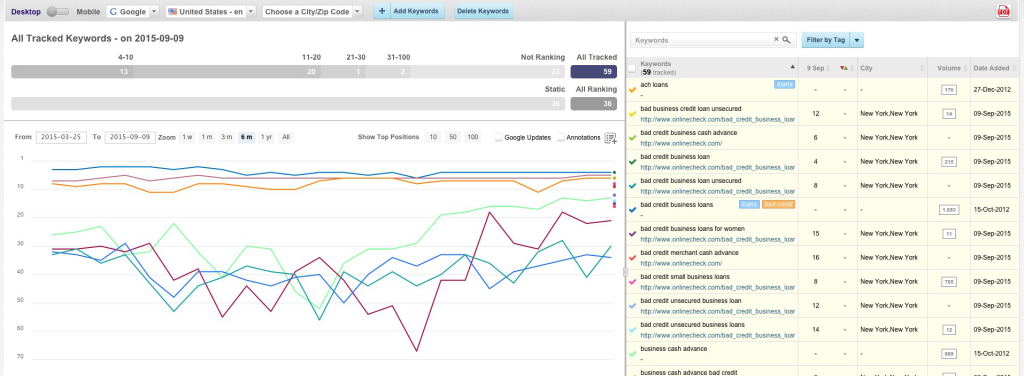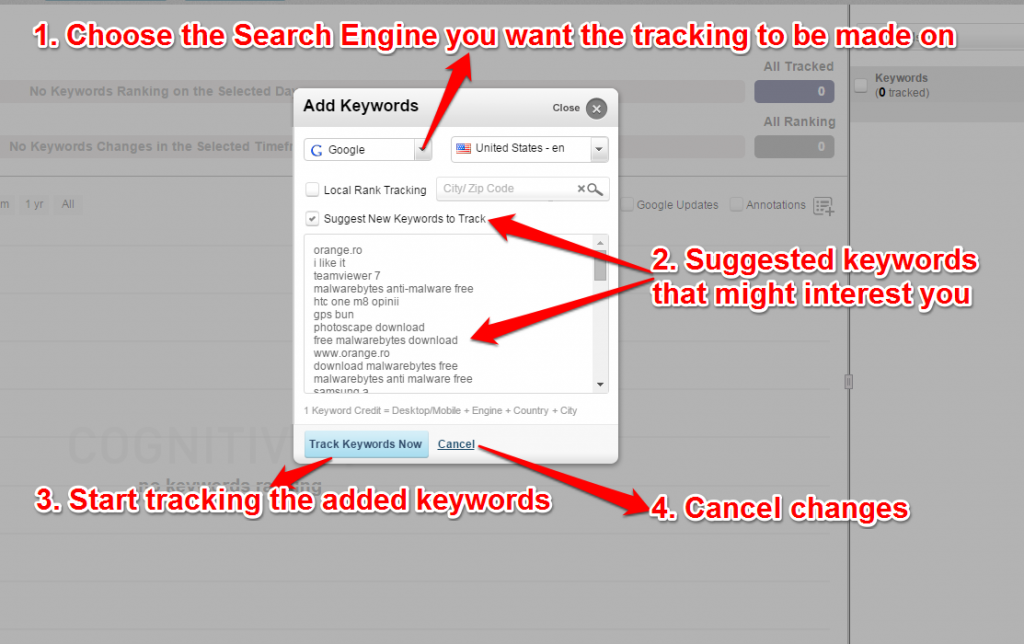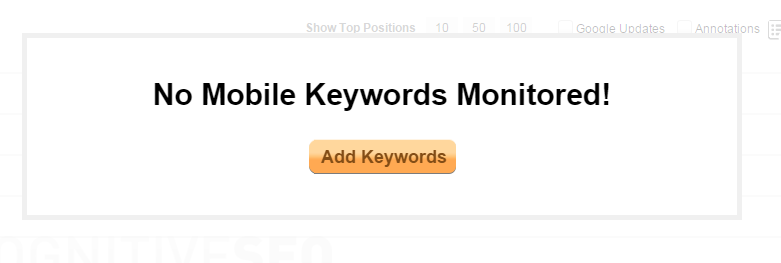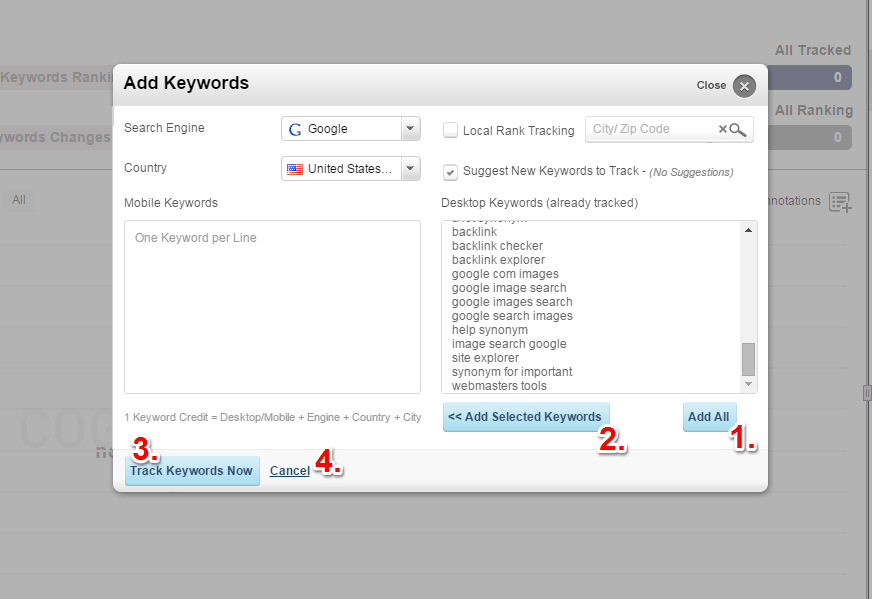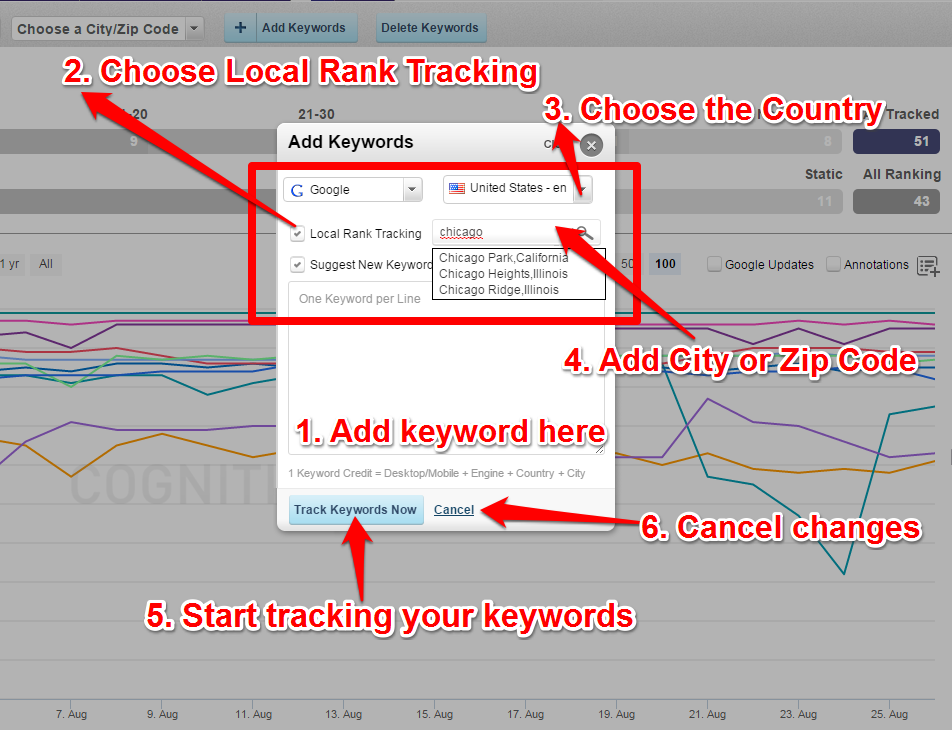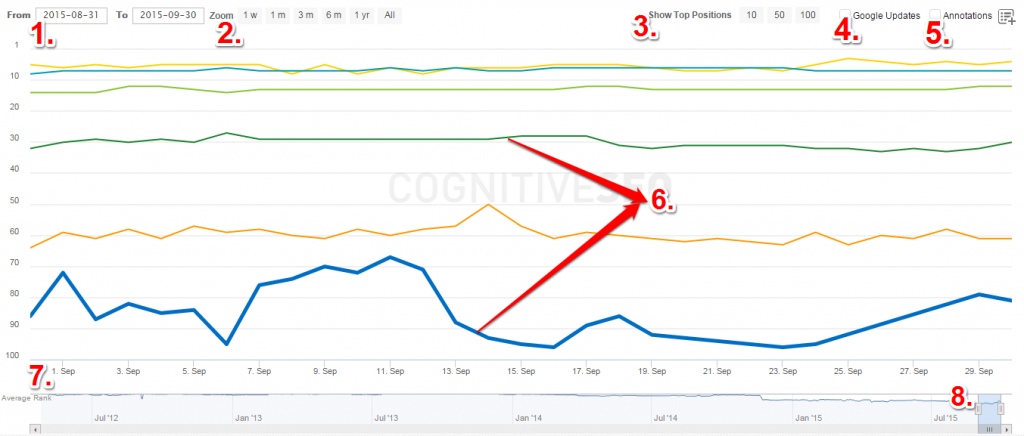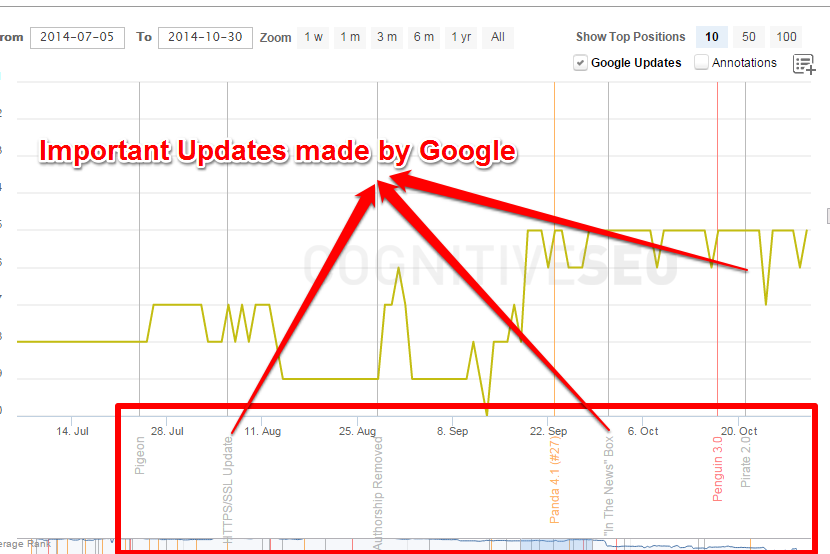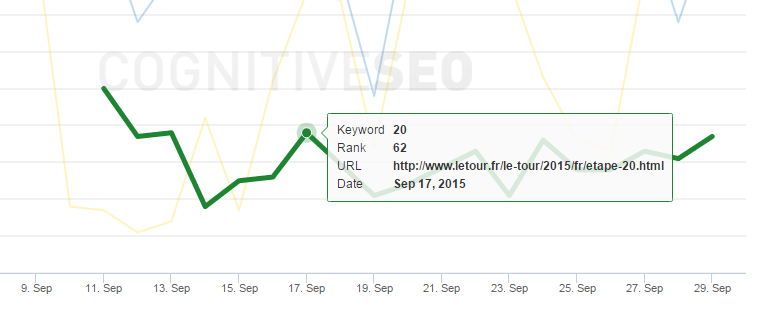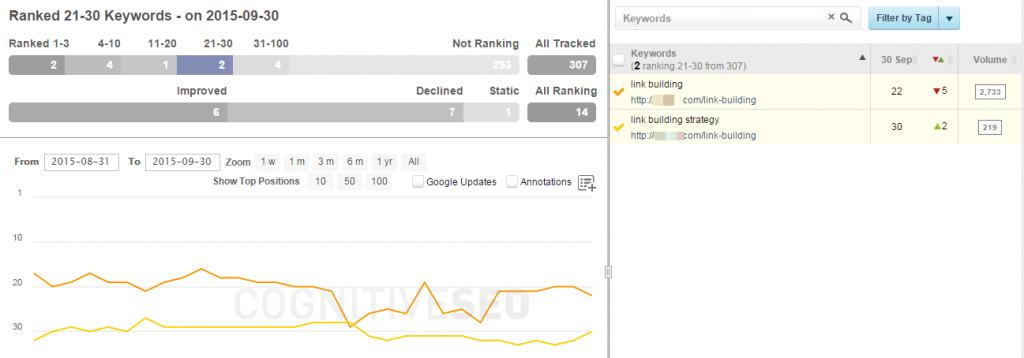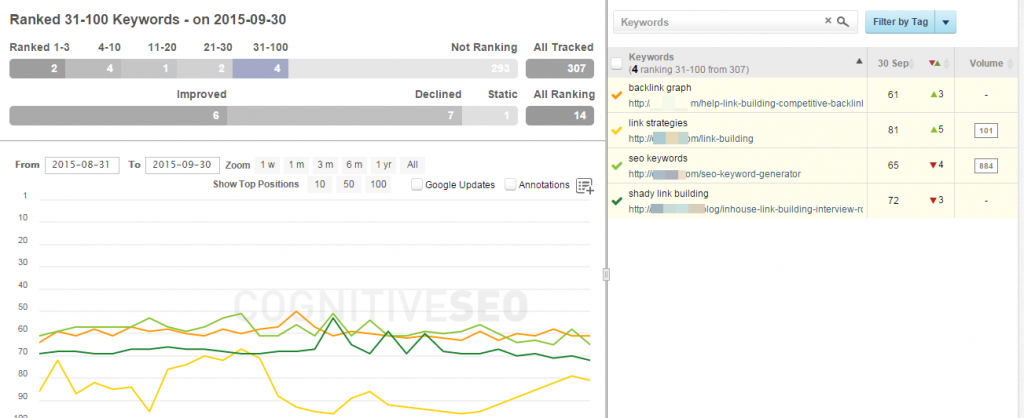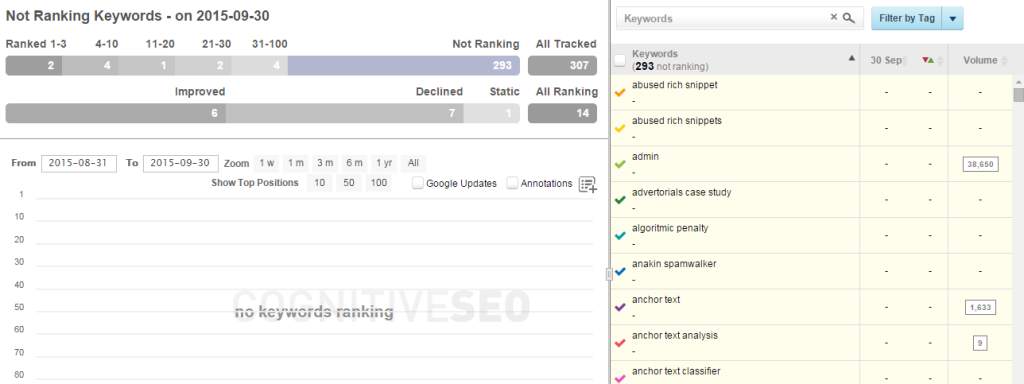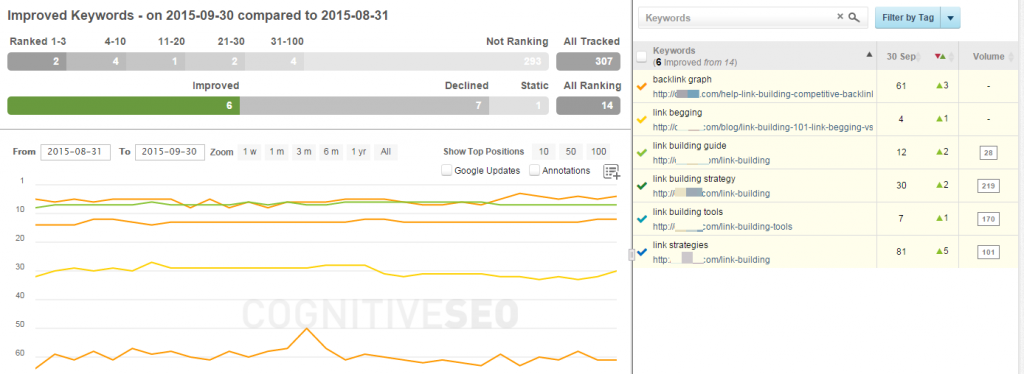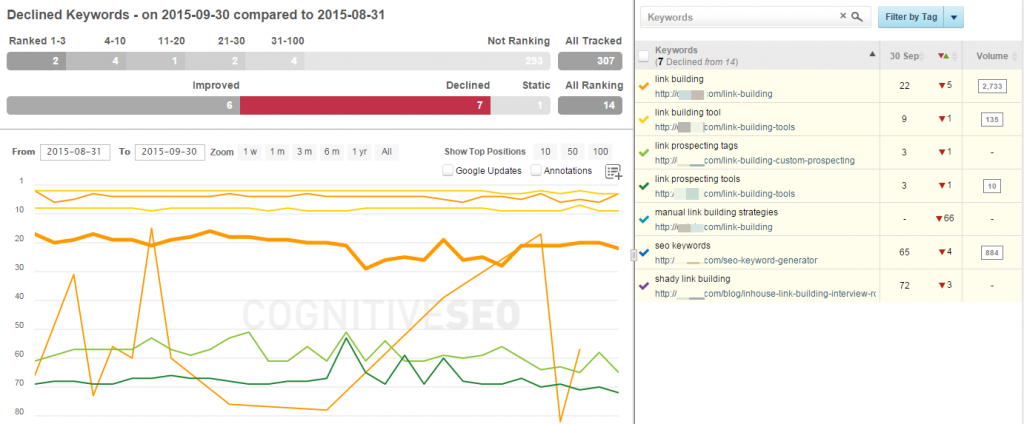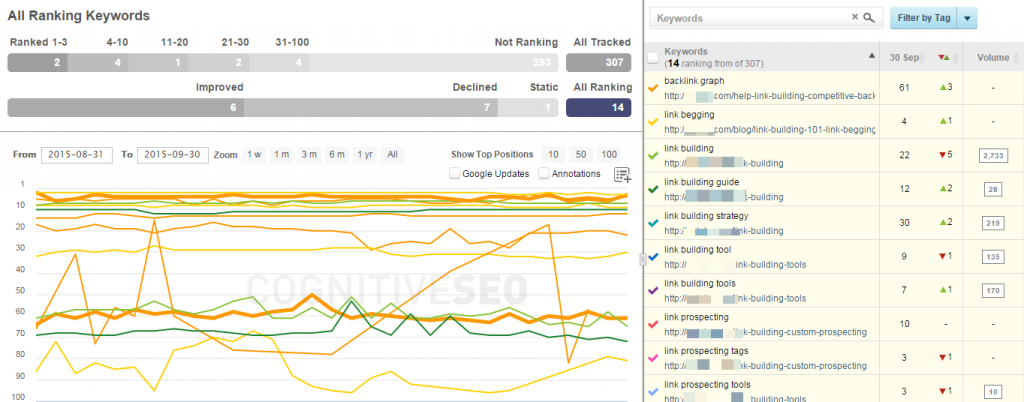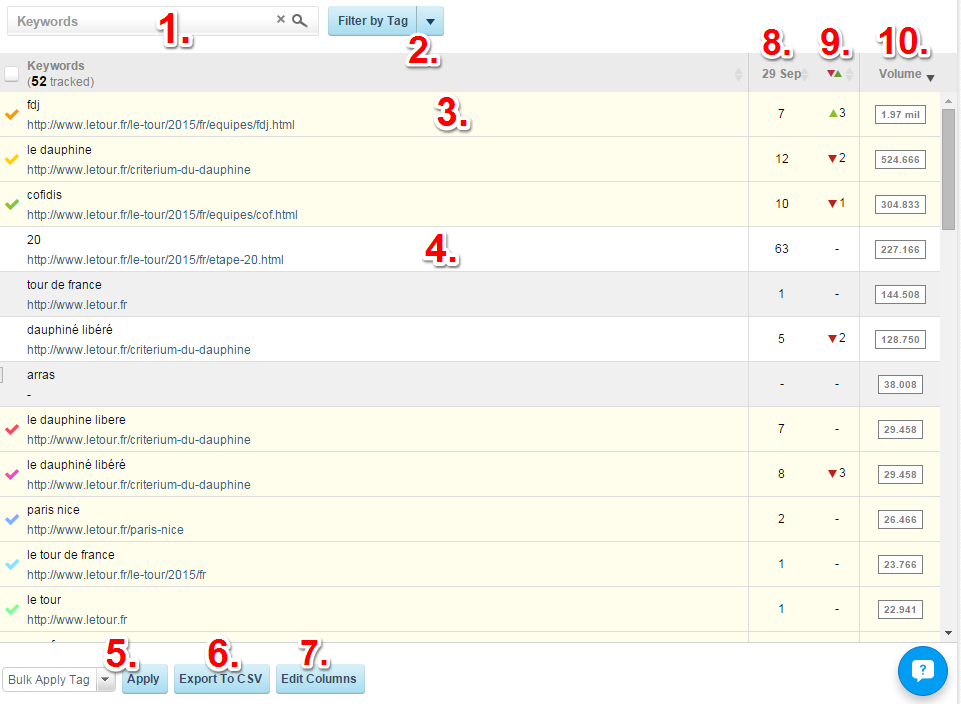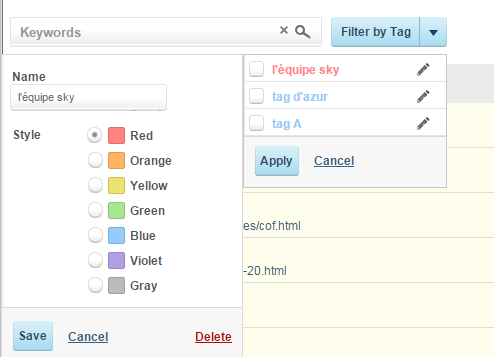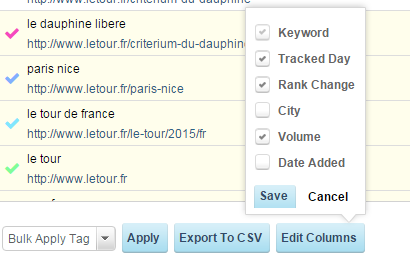One of the main factors of your website’s performance is the ability to accurately track its rankings. cognitiveSEO’s SERP Checker provides one of the most in-depth keyword analyses. Tracking your keywords daily at a universal or local level, our tool gives you a complete view of your real rankings, helping you make the correct strategic decisions.
You can track the keywords you are most interested at a universal, local level, on desktop or mobile devices. Understanding the power of contextualized rankings, we integrate mobile keyword search, giving you a detailed perspective of your real rankings, with more combined specific data at your fingertips. You can get accurate results through our local/universal rank tracker. Because the same keyword can rank differently in a campaign on more locations, our tool helps be in touch with your real rankings.
Desktop and Universal Tracking
When you first enter the rank tracking module, a message like one from the screenshot below will appear. In order to start adding keywords, press the “Add Keywords to Get Started” Button.
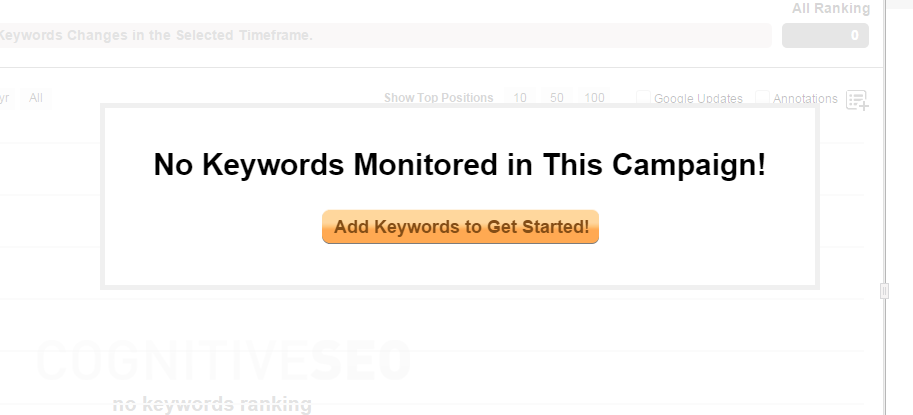 Once you press the “Add Keywords to Get Started!” button, a pop up like one from below will appear.
Once you press the “Add Keywords to Get Started!” button, a pop up like one from below will appear.
1. You can choose the Search Engine you want to make the tracking on. You can choose between Google, Yahoo and Bing.
2. If you check the “Suggest New Keyword to Track” box, a list with suggested keywords will appear. The suggestions are made based on your campaign info, the search engine chosen, the device you want to make the search on and the country you are making the search on. All the keywords from that list can be edited, deleted or replaced, partially or entirely.
3. Press the “Track Keywords Now” button in order to start tracking the keywords that you’ve just added.
4. Click the “Cancel” button if you want to close the pop-up or if you don’t want to apply the changes that you’ve made.
In order to switch between desktop and mobile rank tracking, simply use the switcher from the left side of the page, just like shown in the image below.
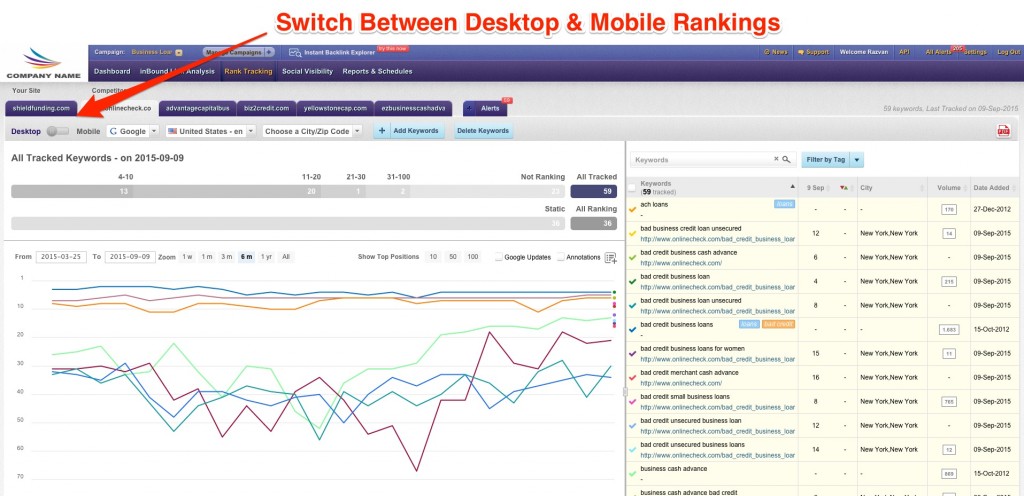
You can choose to track your keywords on desktop or mobile. For each category, desktop or mobile, you need to add a list of keywords to track. When you add Mobile tracking for the first time, a message like the one in the image below will appear.
Once you push the “Add keywords” button, another pop up will appear, where you will have the possibility to add the keywords you want to track on mobile. You can manually enter the keywords you are interested in or you can choose from the existent desktop list.
1. The “Add All” button gives you the possibility to add all the keywords from the desktop tracked keywords list to the mobile keywords list.
2. You can choose to add just some of the keyword from the desktop list, by clicking them. After you’ve finished with your selection, you can click on “Add selected keywords” button and those specific keywords will be moved to the mobile tracking list.
3. After you finished adding the keywords, you can click on “Track Keywords Now” so that the tracking process began.
4. From here you can Cancel the changes that you’ve previously made.
You can choose to track your keywords at a universal or at a local level. If you want to track your keywords at a local level, just press the “Add keywords” button and follow the steps from the image below.
1. Add the keyword you are interested in tracking.
2. Choose local rank tracking by checking the “Local Rank Tracking” box.
3. Choose the country you want your keywords to be tracked in.
4. Add the name of the City you are interested in or its Zip Code.
5. Press “Track keywords now” to start adding those keywords to the tracking list.
6. Press “Cancel” if you don’t want that the changes that you’ve made to be registered.
Visualizing your ranks is now made easy as we put at your disposal a lot of options of looking over the rankings you are most interested in, on the periods of time chosen by you.
Using the Rankings Chart
Once you’ve added keywords, they are going to be tracked on a daily or weekly basis, on your choice. You can change your rank tracking frequency directly form the dashboard.
The tracked keywords’ rankings will be showing in a chart, similar to the one from the screenshot below.
1. From here you can set the period of time you want to see your rankings for. You cannot set a date previous than the date you started tracking your keywords with cognitiveSEO.
2.This is a shortcut that allows you to see the charts directly for specific periods of time.
- 1w= 1 week
- 1m = 1 month
- 3m = 3 months
- 6m = 6 months
- 1yr = 1 year
- All = All the period of time that the keywords have been tracked
3. “Show top positions” allows you to see, on your choice, only the keywords ranking on position 1-10, 1-50 or 1-100.
4. By checking the Google Updates box you will be able to see all the important updates made by Google, in the period of time selected by you.
5. The Annotations will populate your rankings chart with the annotations you’ve previously added. If you don’t have any annotations, you can click on the icon next to “Annotation” and add a new one. Once you press this button, a pop up like one shown below will appear. You can add as many annotations as you want. You can easily manage your annotations by giving each of it a Name, a Date and a Color. This way, it will be easier for you to visualize and find on the chart.
6. Each keyword’s evolution is represented on the chart with a line of a certain color. In order for you to visualize your rankings easier, a large palette of colors is used. Yet, as you might have many keywords tracked, the colors might repeat from time to time. Once you hover on a line from the chart, the line will get thicker and you will be given extra info on that keyword’s evolution, just like you can see in the screenshot below: the name of the keyword, the rank on the point that you have your pointer on, the URL and the date you are hovering over.
7. Here you can see the period of time for which you can see the rankings for. There are dates added frequently so it would be easier for you to follow your keywords’ evolution.
8. At the bottom of the page you have the whole period of time on which the keywords shown in the chart have been tracked. On this period of time you can see a line that shows you the average ranking for the whole period. On the right side, there is a slider that can be dragged in order to see the period of time you are most interested in. Once you drag the slider, the dates from the top of the chart (number 1.) will automatically change.
Just above the rankings chart, you several options that might come in hand when trying to manage the tracked keywords or when you want to visualize certain some specific rankings.
1. Switch between desktop and mobile tracking.
2. See rankings from a certain search engine. Depending on the search engine you have your keywords set on, you can choose between Google, Yahoo and Bing.
3. See rankings for a specific country/city that you’ve previously added.
4. Add more keywords to track. Once you choose this option, a pop up like the one below will appear. As explained above, you can add keywords to be tracked at a universal or local level, you can choose to have suggestion listed or not and you can also choose the search engine you want your tracking to be made on.
5. Delete keywords that you don’t want to track anymore. Once you choose this option, a pop up like the one below will appear. You can check the keyword(s) you want to remove from tracking and after that press the “delete” button. You can also find specific keywords with the “filter by keyword” option. If, for instance you are tracking a keyword on desktop and mobile as well, you can choose to deleted from both places or only from one of them. The same thing applies if you are tracking a keyword on several search engines or on several locations.
6. Each section of the bar is delimited, letting you easily see the rankings for certain position. Here you can see the rankings for keywords that ranked for position 1-3 in the mentioned date. On the bar you will have the number of keywords ranking for those positions. The bar is grey and once is clicked it changes its color, letting you know that is selected. When the “Ranked 1-3” bar is pressed, not only the chart below will show the rankings for these keywords, but also the table on the right side you will be able to see those keywords, with all the info associated to them. Below you have a screenshot on how does the chart rank tracking page looks like when one of the section is selected. The screenshot below is taken for the situation “Ranked 1-3”.
7. Once you select this section, you will see the rankings for the keywords ranking on the position 4-10.
8. Once you select this section, you will see the rankings for the keywords ranking on the position 11-20.
9. Once you select this section, you will see the rankings for the keywords ranking on the position 21-30.
10. Once you select this section, you will see the rankings for the keywords ranking on the position 31-100.
11. Once you select this section, you will see the list of keywords that are not ranking.
12. Once you select this section, you will see the rankings for all tracked keywords.
13. Once you select this section, you will see the rankings for all the keywords that improved comparing to a previous date.
14. Once you select this section, you will see the rankings for all the keywords that declined comparing to a previous date.
15. Once you select this section, you will see the rankings for the keywords that are static comparing to a previous date.
16. Once you select this section, you will see the rankings for all the keywords that are ranking.
On the right side of the Rank Tracking page you have a table where there are displayed the keywords tracked by you. As stated before, this table is highly correlated with the ranking chart, meaning that any change on that chart will be visible on this table as well. If, for instance, you want to see only the improved keywords on the chart, here you will be listed with the list of improved keywords only. This table is similar with the one from the screenshot below.
1. You have the possibility to Search for a keyword so you won’t have to scroll through all the keyword list. Once you type a word and press enter or the magnifier glass icon, in the table only the searched keyword will be displayed.
2. To each keyword a tag can be attributed. If you want to see only certain keywords that have a specific tag, you can filter them after the tag they have. Once you filter them this way, you will visualize only the keywords with the tag that you wanted. Just like in the screenshot below, you need to check the box with the tags you are interested in and hit apply. On the right side of the tag you have the option to Edit the tag. You can change its name, or its style. Once you are done with the changes, you need to press the ” Save” button. You can also delete a tag by pressing the “Delete” button.
3. All the keywords that are selected and shown in the ranking chart from the left side are highlighted with the yellow color. Once you hover over a keyword, you will have the possibility to add a tag to it. You can see on the previous point how you can edit and filter after a tag.
4. The keywords that are not selected nor showing on the chart from the left side are highlighted with the grey color. You can hover over these keywords and add tags to them as well.
5. You can select the keywords you are interested in and after that, depending on the case, you can bulk add or delete tags. In order for that action to be completed you need to hit the “Apply” button.
6. If you hit the “Export to CSV” button a “Save Us” window will open and you will be able to download all the data from the table in a CSV format.
7. You can Edit the columns you want to see in the keywords table. Once you hit this button, you will have the options to check or uncheck the columns you want to see in the table, just like in the screenshot below. Between the keywords table and the rankings chart there is a slider, letting you adjust the space you want to have in one side or another. This way, you can add several columns that will be easily visible in the table.
8. On this column you have the date you are seeing the keywords ranking for .
9. From this column you can order the keywords according to the changes in positions.
10. On this column you have the volume for each keyword. From the arrow found near the “volume” word you can order the keywords after volume criteria.
On the right side of the page, you have a PDF icon from where you can create your report. More info about how to create automated, fully personalized reports can be found here.
Depending on the subscription you are on, you have assigned a certain number of keywords and each tracked keyword “consumes” one credit from that number. For each type of search, a credit from the total number of keywords will be counted. If, for instance you track one keyword on Mobile devices, on Google, in Chicago, USA, one credit will be “consumed” from the total number of credits (number of keywords). If you choose to track the same keyword at a universal level, on desktop, another credit will be “consumed”.
1 Keyword Credit = Desktop/Mobile + Engine + Country + City

